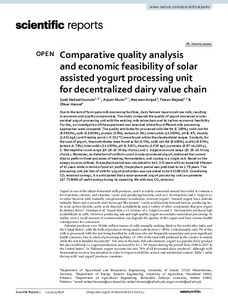Datum
2023-04-27Schlagwort
630 Landwirtschaft, Veterinärmedizin WertschöpfungsketteMilchproduktionJoghurtherstellungSolartechnikMetadata
Zur Langanzeige
Aufsatz

Comparative quality analysis and economic feasibility of solar assisted yogurt processing unit for decentralized dairy value chain
Zusammenfassung
Due to the lack of farm-gate milk processing facilities, dairy farmers have to sell raw milk, resulting in economic and quality compromises. The study compared the quality of yogurt processed in solar assisted yogurt processing unit with the existing milk value chain and its techno-economic feasibility. For this, an investigation of the experiment was executed where four different milk processing approaches were compared. The quality attributes for processed milk like fat (5.283%), solid-not-fat (9.0833%), salts (0.6833%), protein (3.8%), lactose (4.1%), total solids (14.383%), pH (6.87), density (1.031 kg/L) and freezing point (− 0.532 °C) were found within the standardized ranges. Similarly, for the case of yogurt, these attributes were found as fat (5.5%), solid-not-fat (8.683%), acidity (0.93%), lactose (4.73%), total solids (14.183%), pH (4.3433), density (1.039 kg/L) syneresis (9.87 mL/100 g), S. thermophilus count range (10.18–10.30 log cfu/mL) and L. bulgaricus count range (10.26–10.34 log cfu/mL). Moreover, no detection of coliform count in solar-processed yogurt, endorsed the current idea to perform three processes of heating, fermentation, and cooling in a single unit. Based on the energy sources utilized, the payback period was calculated to be 1.3–9 years with an expected lifespan of 15 years while in terms of product profit, the payback period was predicted to be 1.78 years. The processing cost per liter of milk for yogurt production was calculated to be 0.0189 USD. Considering CO₂ emission savings, it is anticipated that a solar-powered yogurt processing unit can generate 107.73 MWh of useful energy during its operating life with zero CO₂ emission.
Zitierform
In: Scientific Reports Volume 13 (2023-04-27) eissn:2045-2322Förderhinweis
Gefördert durch den Publikationsfonds der Universität KasselZitieren
@article{doi:10.17170/kobra-202311088986,
author={Husnain, Syed Nabeel and Munir, Anjum and Amjad, Waseem and Majeed, Faizan and Hensel, Oliver},
title={Comparative quality analysis and economic feasibility of solar assisted yogurt processing unit for decentralized dairy value chain},
journal={Scientific Reports},
year={2023}
}
0500 Oax
0501 Text $btxt$2rdacontent
0502 Computermedien $bc$2rdacarrier
1100 2023$n2023
1500 1/eng
2050 ##0##http://hdl.handle.net/123456789/15186
3000 Husnain, Syed Nabeel
3010 Munir, Anjum
3010 Amjad, Waseem
3010 Majeed, Faizan
3010 Hensel, Oliver
4000 Comparative quality analysis and economic feasibility of solar assisted yogurt processing unit for decentralized dairy value chain / Husnain, Syed Nabeel
4030
4060 Online-Ressource
4085 ##0##=u http://nbn-resolving.de/http://hdl.handle.net/123456789/15186=x R
4204 \$dAufsatz
4170
5550 {{Wertschöpfungskette}}
5550 {{Milchproduktion}}
5550 {{Joghurtherstellung}}
5550 {{Solartechnik}}
7136 ##0##http://hdl.handle.net/123456789/15186
<resource xsi:schemaLocation="http://datacite.org/schema/kernel-2.2 http://schema.datacite.org/meta/kernel-2.2/metadata.xsd"> 2023-11-16T16:11:45Z 2023-11-16T16:11:45Z 2023-04-27 doi:10.17170/kobra-202311088986 http://hdl.handle.net/123456789/15186 Gefördert durch den Publikationsfonds der Universität Kassel eng Namensnennung 4.0 International http://creativecommons.org/licenses/by/4.0/ Energy science and technology Engineering 630 Comparative quality analysis and economic feasibility of solar assisted yogurt processing unit for decentralized dairy value chain Aufsatz Due to the lack of farm-gate milk processing facilities, dairy farmers have to sell raw milk, resulting in economic and quality compromises. The study compared the quality of yogurt processed in solar assisted yogurt processing unit with the existing milk value chain and its techno-economic feasibility. For this, an investigation of the experiment was executed where four different milk processing approaches were compared. The quality attributes for processed milk like fat (5.283%), solid-not-fat (9.0833%), salts (0.6833%), protein (3.8%), lactose (4.1%), total solids (14.383%), pH (6.87), density (1.031 kg/L) and freezing point (− 0.532 °C) were found within the standardized ranges. Similarly, for the case of yogurt, these attributes were found as fat (5.5%), solid-not-fat (8.683%), acidity (0.93%), lactose (4.73%), total solids (14.183%), pH (4.3433), density (1.039 kg/L) syneresis (9.87 mL/100 g), S. thermophilus count range (10.18–10.30 log cfu/mL) and L. bulgaricus count range (10.26–10.34 log cfu/mL). Moreover, no detection of coliform count in solar-processed yogurt, endorsed the current idea to perform three processes of heating, fermentation, and cooling in a single unit. Based on the energy sources utilized, the payback period was calculated to be 1.3–9 years with an expected lifespan of 15 years while in terms of product profit, the payback period was predicted to be 1.78 years. The processing cost per liter of milk for yogurt production was calculated to be 0.0189 USD. Considering CO₂ emission savings, it is anticipated that a solar-powered yogurt processing unit can generate 107.73 MWh of useful energy during its operating life with zero CO₂ emission. open access Husnain, Syed Nabeel Munir, Anjum Amjad, Waseem Majeed, Faizan Hensel, Oliver 14 Seiten doi:10.1038/s41598-023-34032-y Wertschöpfungskette Milchproduktion Joghurtherstellung Solartechnik publishedVersion eissn:2045-2322 Scientific Reports Volume 13 false 6878 </resource>
Die folgenden Lizenzbestimmungen sind mit dieser Ressource verbunden:


